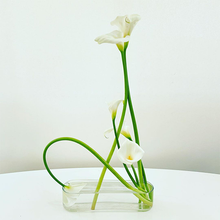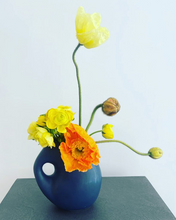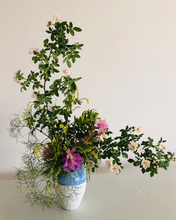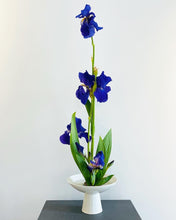Three sunflowers blossoming on three levels of a glass vessel, the stems of ethereal arums bended and curved into a delicate sculpture, and bamboo in a play of balance strained on a thin stick, Jessica shares with us her passion for the traditional Japanese art of flower arrangement, with her Atelier Ikebana.
Ikebana, literally means ‘living flowers.’ This Japanese flower art is a philosophy, an appreciation of our living world, the little things we tend to overlook, the beauty in the ephemeral. With Ikebana, flowers, branches, leaves, and fruits are arranged according a set of rules, and within these principles, self-expression flows in alignment with nature. A classic flower bouquet would often carry greenery of similar size and height, but with Ikebana, like in nature, things are not aligned. Colors, lines and mass are the key elements that guide the piece of art, creating a sense of harmony, between spaces, playing with lightness and masses, it’s a personal expression within rules that encourage us to explore and discover unexpected properties of nature. Jessica discovered for example how branches can be flexible, that there are many kinds of eucalyptus or that ‘you can make angles with flowers, you feel their energy when you start applying the rules.’ She’s been doing it for five years now and tells us ‘every time you create something new and realize the energy of it, it’s astonishing what you can create.’ In spring, she looks for blossoms; from cherry, apple, or peach trees, she’s attracted to trees with lots of branches and their colorful blossoms but also found out that with the warm weather in Lebanon, some trees blossom beautifully in Autumn, and she uses those branches with their leaves, their flowers, their fruits. Fruit arrangements themselves are one kind of Ikebana called Morimono, in which you arrange fruits and vegetables into an art piece, keeping in mind that they will be eaten afterwards. Morimono arrangements do not need vessels, but for flower arrangements, you will need a vessel for the water, so Jessica even learned about shapes and materials. She tells us you can create your own vessel, with wires, tubes, reused plastic or even cardboard and glass… The passionate lady also explored other arts that she encountered through Ikebana like Wabi Sabi a concept that embraces impermanence and imperfection, embodied in the art of Kintsugi; mending a broken object, like a vase, with gold dusted lacquer, revealing the beauty of imperfection.
Jessica discovered Ikebana while she was living in Shanghai. She stayed there 7 years, and one day heard of a workshop organized by the French community, she signed up just out of curiosity. She was attracted by the flowers world and just wanted to see what this was about. As it turned out, she discovered a whole world that she didn’t know existed, with its own philosophy, its schools, programs, and communities across the globe. ‘There are communities for Ikebana in every country, here in Lebanon it is still new,’ but she is already in touch with the community in Dubai and created ‘new friendships through flowers.’ She kept going to classes and traveled to Japan where she dug deeper and discovered the discipline and appreciation behind this art. ‘For each flower, for each season you develop a creation, you use seasonal flowers and start looking forward to each season.’ Jessica has a penchant for lines, playing with angles and positions using traditional tools. Some of the tools used for Ikebana did not exist in Lebanon so she brought with her a Kenzan, a device used for fixing flowers in their vessel. ‘You discover yourself, are surprised what you can create.’ ‘When you learn something beautiful you want to share it.’ On top of customized arrangements and displays that she prefers to create on location, Jessica offers one-time Ikebana workshops for amateurs but also workshops to become teachers. She is certified from the Sogetsu school; ‘Ikebana you pass it on, your students become teachers.’ At the atelier she offers various workshops and events highlighting Japanese culture, such as origami, calligraphy, mosaic or pottery, but also sake tasting, and hosts Japanese artist. For us amateurs, she tells us we can start with flowers and branches we find around the house ‘you can use any flower’ and we do not necessarily need tools. She tells us of a magnolia she used for a piece, the flower lasts only one night after it is cut, or the art of catching the beauty in a fleeting moment.








